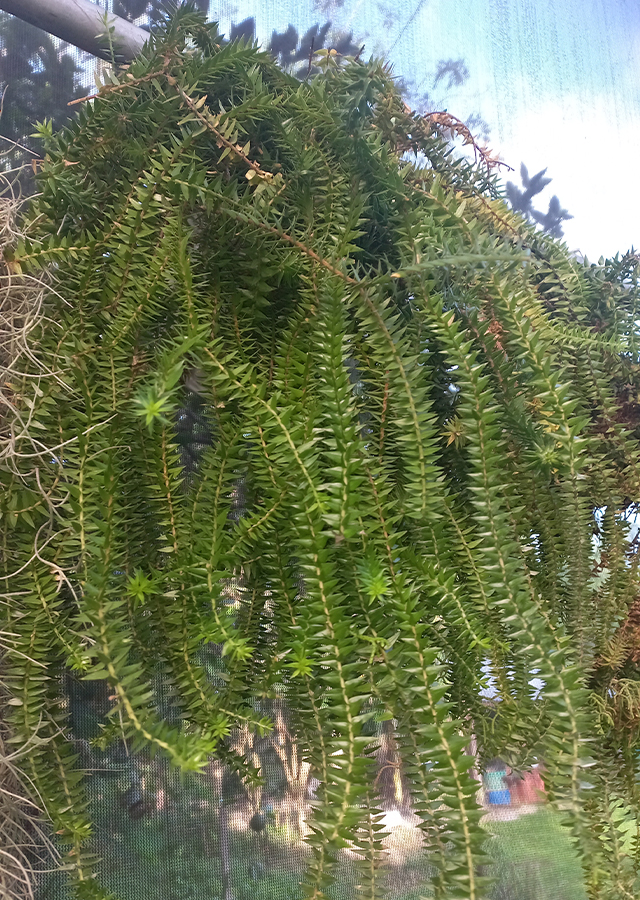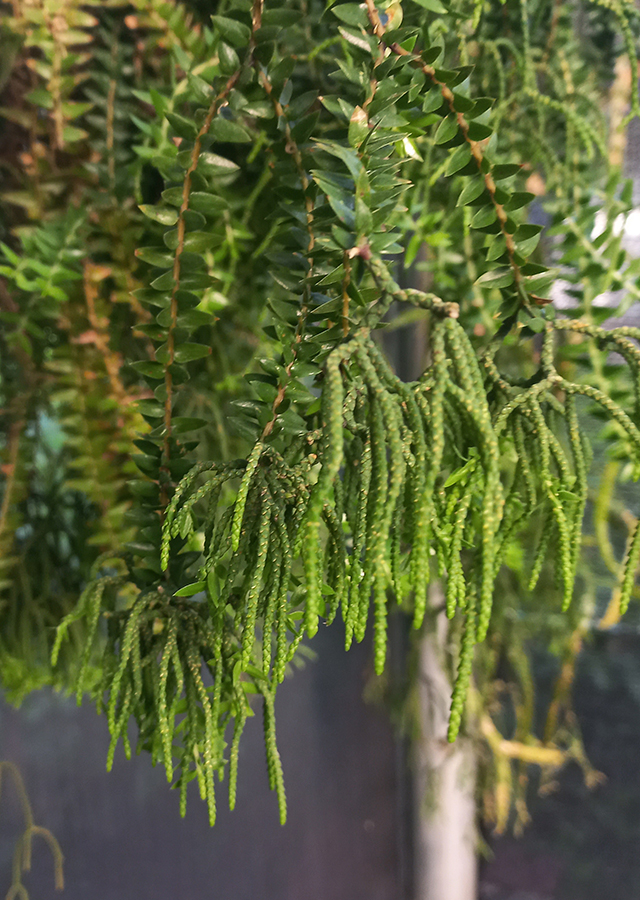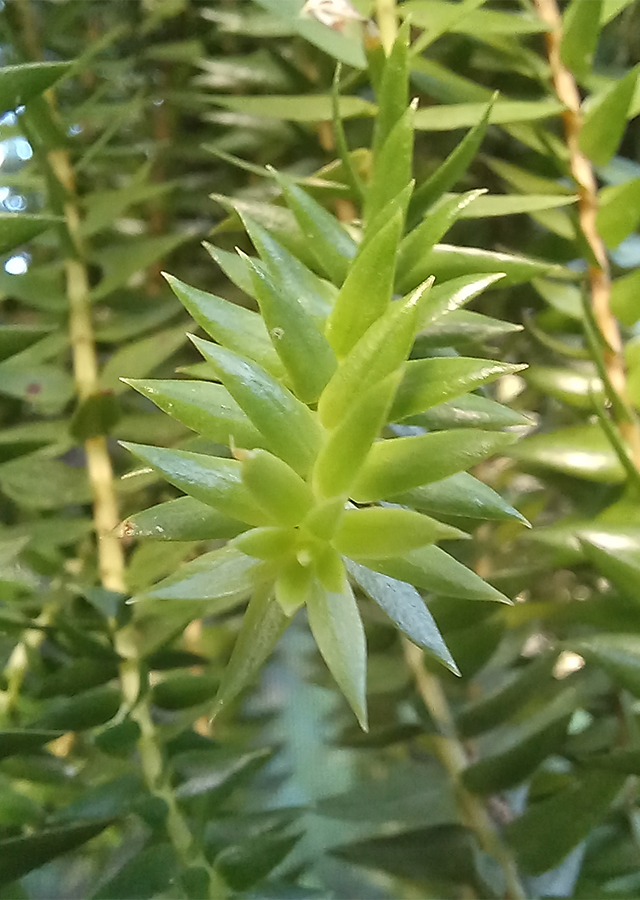Common Tassel Fern
Huperzia phlegmaria (L.) Rothm.
Lycopodiaceae
Location in our garden
Green House



Synonym
Huperzia feejeensis (Luerss.) Holub
Huperzia simonii (Nessel) Holub
Lepidotis phlegmaria (L.) P.Beauv.
Habitus
Herbaceous. An epiphytic, repeatedly forked, perennial, pendulous herb, growing up to about 2 m long
Part Used
Leaves
The Whole Plant
Growing Requirements
Need Shade
Drought Resistant
Habitat
Forest
Mountains
Terrestrial
Overview
Huperzia phlegmaria is an epiphytic species of tassel like club moss native to rain forests in Madagascar, some islands in the Indian Ocean, Asia, Australia as well as many Pacific Islands. The plant is known as a club moss because the sporophylls resemble clubs. As a result, the name club moss is commonly used for any species within the class Lycopodiopsida which are scientifically considered primitive plant species. Scientists believe the Lycopodiopsida were a dominant group of species during the Carboniferous Period. The Carboniferous Period is thought to have occurred some 354 to 290 million years ago during the Paleozoic Era. It is used as an ornamental, commonly grown as a hanging plant. In South-East Asia, it is used to wash hair in the belief that it stimulates hair growth.
Vernacular Names
Tagolailai (Tagalog-Philippines), Kompoi kmeng (Cambodia), Yom doi (Thailand), Rêu cây (Vietnamese).
Agroecology
H. phlegmaria occurs in relatively cool, partially shaded locations on mossy tree trunks or on rocks, preferring abundant moisture but tolerating dryness, in forests usually at 800-2,300 m altitude. This fern enjoys a well draining, airy, epiphytic substrate and seldom repotting. The species requires high nitrogen fertilizer in order to thrive. In the tropics daily watering is necessary.
Morphology
- Root - considered a sporophyte, it possesses true roots with an aerial stem.
- Stem - pendulous, (15-)40-80(-190) cm × 1-2.5(-5) mm, 1-4 times branching into two equal branches at irregular intervals, brown, dark and lustrous in the oldest parts, paler near the growing point, coarse.
- Leaves - subdistant, slightly twisted, spirally whorled in 4-8 rows, spreading, subpetiolate; lamina triangular to ovate-lanceolate, 4-15(-30) mm × 2.5-7 mm, base rounded-truncate or cordate, margins entire, yellowish-green, coriaceous, midrib prominent.
- Strobili - terminal, cylindrical, (1.5-)4-15 cm × 1-2 mm, distinctly demarcated from vegetative parts of the stem, repeatedly dichotomously branched; sporophylls in four rows, crowded to subdistant, appressed, ovate-subdeltoid, about 1.2 mm × 1.5 mm, entire, green, turning yellowish at maturity, only partly covering the sporangium. Sporangium borne at the base of the sporophyll, reniform, deeply grooved, sessile.
- Spores - triangular, trilete, 35 μm in diameter, bright yellow, granulated.
Cultivation
- These vascular plants lack flowers and sexually reproduce by the production of spores. Spores remain dormant for a long time. When germinating, they develop in the substrate a cylindrical, abundantly branched gametophyte, on which the antheridia and archegonia develop. After fertilization, the sporophyte can start growing.
- Vegetative propagation is by stem cutting, layering, division, and bulbets (which fall to ground when mature, and sprout to form new plants).
- For stem cuttings, remove apical sections (5-15 cm) from stock plant, lay horizontally on well-drained soilless media, and cover cut ends with moist media -- this can be done inside terrariums to maintain humidity. Upward-turning shoot tips are ideal for stem cuttings. Simple layering of stems from rooted plants are said to be much easier to root. New shoots should emerge from the cutting mix in 6-15 months, and can be potted up when they reach 5cm height. Recently-potted plants should be left undisturbed to aid establishment.
Chemical Constituents
Alkaloids lycodoline, lucidioline, lycopodine, flavonoid apigenin, triterpenoid (21β-hydroxy-serrat-14-en-3α-ol), lycophlegmariol B, and lycophlegmariol D.
Traditional Medicinal Uses
- It has been used for the treatment of the neurological disorder.
- Dried plant smoked and fresh leaves used in infusion as tonic or fortifier.
Part Used
Reference Sources
- Amoroso, V. B. (2016). Huperzia phlegmaria (PROSEA). https://uses.plantnet-project.org/en/Huperzia_phlegmaria_(PROSEA). 19-03-2022.
- Exotic Rainforest. (No date). Plants in the Exotic Rainforest Collection: Huperzia phlegmaria (L.) Rothm. https://www.exoticrainforest.com/Huperzia%20phlegmaria%20pc.html. 19-03-2022.
- Kew Royal Botanic Gardens. (No date). Plants of the World Online: Huperzia phlegmaria (L.) Rothm. https://powo.science.kew.org/taxon/urn:lsid:ipni.org:names:169764-3. 19-03-2022.
- National Park of Singapore. (2021). Flora & Fauna Web: Phlegmariurus phlegmaria. https://www.nparks.gov.sg/florafaunaweb/flora/3/7/3746. 19-03-2022.
- Plant Circle. (No date). Huperzia Phlegmaria. https://plantcircle.co/products/huperzia-phlegmaria/. 19-03-2022.
- Thu, D.K., et all. (2020). The Effect of Alakaloid Extracted from Huperzia Phlegmaria on Cognitive Deficits scopolamine-Induced in Mice. Bentham Science Publisher. DOI: 10.2174/1573407216999200520082046. Also available on https//:www.euraselect.com/article/106782.

